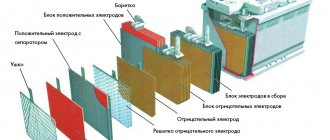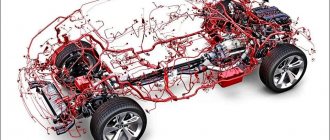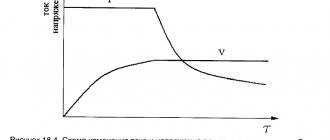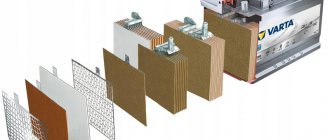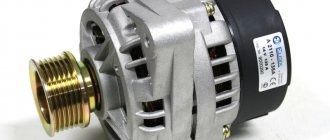Any battery-type batteries require regular recharging. Not everyone knows how to charge a gel battery. A specific electrolyte requires the use of special methods for restoring capacity. Following certain rules will help avoid element failure.
On the left is a gel battery using AGM technology, on the right is a gel battery using GEL technology.
What are gel batteries?
A gel battery is a conversion product of a classic battery. The liquid filler was replaced with a gel filler. The operating principle is no different from that of conventional lead-acid batteries.
There are 2 options for manufacturing such batteries:
- GEL technology. In this case, a microporous separator filled with silica gel is used.
- AGM technology. The body contains fiberglass impregnated with an acid composition. The same material serves as a separator.
Products produced using these technologies are used in automobile and shipbuilding. They power devices that require uninterrupted power supply. Batteries with a gel filler are rarely installed in cars.
However, they are in demand among owners of motorcycles and mopeds. The battery lasts at least 10 years. It works properly in any position. The tightness of the housing prevents leakage of electrolyte.
Advantages
The advantages of gel power sources include the following qualities:
Gel batteries are safe and have a long service life.
- High inrush current. The gel filler adheres tightly to the lead electrodes. This helps the user in winter.
- Impossibility of leakage of acid composition. If the housing is slightly damaged, the electrolyte does not drain out.
- Variety of installation options. The battery can be placed on a horizontal, inclined or vertical surface. This is due to the lack of liquid filler.
- Safety. The battery does not emit toxic or explosive fumes.
- Supplying current with stable strength and voltage. The parameters do not change even when the charge level drops to 30%.
- Long service life. The battery can withstand up to 700 discharge and charge cycles. Some models do not lose capacity even after 1000 charges.
- Insensitive to temperature changes. When heated or cooled, the gel-like electrolyte retains its properties.
Flaws
The negative qualities of GEL batteries include the following:
- The need to comply with operating rules. This is the only way to extend battery life. The battery must be properly charged and prepared for storage.
- The need to use automatic chargers that regulate voltage and current.
- Increased cost compared to classic batteries.
An example of specialized chargers for lead-acid and gel batteries from Optima and Universal.
Distinctive features from conventional batteries
A gel battery is an optimized version of the classic battery, which has a similar operating principle, but a different design.
The main feature is the replacement of the electrolyte-liquid with a gel.
The advantage of the technology is to protect the working fluid from leakage, regardless of the position of the housing, which made the battery in demand among owners of motorcycles, cars, and watercraft.
Can a gel battery be charged with a regular charger?
It is not advisable to use a regular memory. Connecting such a device directly can damage the battery beyond repair. When a high current is applied, the gel begins to melt. Liquefied filler cannot return to its original state. It continues to melt the remaining gel.
When charging a gel battery with a classic charger, the following problems may arise:
- Stops charging when reaching 90%.
- Inability to fine-tune parameters. It will not be possible to force the battery to accept current of inappropriate power.
- Battery overheating. In this case, you need to immediately turn off the charger. When using a non-automatic device, the user will have to monitor the charging process.
Do these batteries need to be serviced?
Gel batteries do not require maintenance and are often produced in a sealed case, because the gel cannot be filled.
Manufacturers indicate a battery life of 10 years. However, such long-term operation can only be achieved by following all operating rules. The service life of these devices is negatively affected by both too low (less than -30°C) and high temperatures (more than +50°C). Therefore, it is recommended to store the gel storage device in a warm, dry place in winter.
Also, battery life is negatively affected by overcharging the battery. Constant undercharging is also undesirable.
Such devices can store energy for quite a long time, but they still need to be recharged, which is carried out at least once a season.
Basic rules for safe charging
When restoring the power of a battery with a gel filler, you must follow these rules:
- The charge level must be checked every 2-4 weeks. You can do this yourself using a multimeter. You need to start the engine and connect the probes of the device to the battery terminals.
- The voltage limit must be observed. This indicator should not exceed 14.5 V. During charging, the parameter changes. The deeper the discharge, the higher the current. As the charge is restored, the indicators decrease. Exceeding permissible levels leads to melting and boiling of the electrolyte.
- Do not try to open the case if the filler boils. This may cause the battery to explode and injure the user.
When fully charged, the voltage at the terminals of the gel battery should not exceed 14.5 V.
Brief summary
Charging a gel battery is not much different from a similar procedure with classic car batteries. There is only one important rule - do not exceed the charge voltage. If this moment is missed, the GEL battery will deteriorate irrevocably. The gel-like electrolyte will lag behind the lead plates, the capacity will decrease, the inrush current will possibly inflate the case. Later, such a battery may “refuse” to accept a charge.
If you have anything to add to this material, write your thoughts in the comments. Useful information will definitely be useful to someone, and can also be added to this article.
How to charge a gel battery?
Charging must be done using special devices. In this case, you need to set the basic parameters correctly.
Important parameters and features
The intervals between procedures must be at least 6 months. It is necessary to restore the battery's energy potential completely. Otherwise, the battery capacity will decrease over time. It is quite difficult to restore this figure.
The duration of the charging cycle depends on the battery capacity and charging current. The first parameter is divided by the second. With a capacity of 60 A/h and a current of 0.6 A, the cycle duration is 10 hours. Special chargers signal the completion of the procedure.
Charging procedure step by step
Charging a gel battery is done as follows:
- Turn on the charger and measure the current. This will help you choose the optimal operating mode.
- The battery is charged with a current of the same strength that was automatically calculated by the device.
- After 2-3 hours, charging is interrupted. This helps prevent the case from overheating.
- After waiting for the battery to cool, the procedure is resumed, reducing the current. We must not forget about the need to measure the parameter during the cooling period of the battery. If you miss this moment, the charger turns off automatically and the cycle does not resume.
- When the required current is reached, the device is turned off. Non-automatic devices continue to function. Special chargers are equipped with regulators that prevent the gel from melting when the battery heats up.
Marking of gel batteries
The label that is placed on the top or side of the battery will tell you a lot. The main characteristics (capacity, starting current), as well as the production date, will necessarily be present here. True, the latter is most often present in encrypted form, and manufacturers are capable of coming up with the most exotic encryption methods. For example, batteries under the Optima brand use four digits, the first of which indicates the year (for example, 8 is 2018), and the remaining three indicate the day of the year (of which there are 365). So you will have to determine the month and date with a calculator in hand.
But at least everything is clear here, but a code consisting of two letters and two numbers is applied to the Delta battery. There are no problems with the latter - they indicate the day of the month, the month can also be determined by the letter (A - January, B - February, and so on), but the year cannot be determined simply by the letter - you need to look for a correspondence table.
A not entirely clear coding is also used in Varta batteries: the fourth digit indicates the year, and 5–6 indicates the month, with values from 17 to 20 indicating January–April, and May starts from 53 and then goes up.
Other manufacturers have a similar situation, and all because of the lack of labeling standards (they exist, but they are different for Europe, Asia, and the USA).
Instructions for charging a motorcycle battery
12.7 V is the normal voltage of a gel battery for a motorcycle.
The battery of a snowmobile or motorcycle has a lower capacity than the car's power source. A universal car charger does not produce low currents.
Smart devices, such as Benton BX, are used to charge a motorcycle battery. The battery is examined using a multimeter.
The device measures the voltage at the terminals. A value of 12.7 V is considered normal. At a lower value, the gel battery requires recharging.
To extend the battery life, charge it once every 2 months. After long-term storage, the charge is restored within 12-14 hours by applying a current equal to 10% of the capacity. Do not turn off the charger until power is fully restored. You need to monitor the temperature of the battery case.
Is it worth buying a GEL battery for a car?
Let's briefly consider whether it is worth giving preference to a gel battery, abandoning more affordable options. To draw conclusions, we need to go over the advantages of the technology, as well as our main topic - charging.
Manufacturers and sellers attribute the following advantages to GEL batteries:
- increased service life;
- can be tilted and flipped;
- efficient charge reception;
- insensitivity to deep discharges;
- low self-discharge.
All these advantages are really not invented for the sake of advertising and justifying the high cost of gel batteries. They really can last a long time, they can be discharged to zero, and they themselves discharge very, very slowly. But only under one condition - if the GEL battery was charged correctly throughout its service life.
Therefore, if you are not sure that you can charge a gel battery as described below, then it is better not to buy it. First, overpay for benefits you'll never get. Secondly, today there is a worthy and more affordable alternative. In the end, even conventional batteries with liquid electrolyte in modern design can last much longer than the required 5 years. Albeit with some reservations. And for a car battery, such a lifespan is an achievement that deserves respect.
What care does a gel battery require?
You cannot use the vehicle until the battery is completely discharged. When the charge decreases, the battery does not stop functioning. However, the capacity decreases, due to which the battery will not be able to accept the required amount of energy. You need to purchase a multimeter and keep it with you at all times. This will help you detect the low battery in time, connect the charger and recharge.
Additionally, it is recommended to perform the following actions:
- regularly clean the battery case from dust and dirt;
- Once every 3 months, completely discharge and charge the battery;
- check the correct connection of the terminals.
Advantages and disadvantages
Gel battery manufacturing technology has the following advantages:
- No electrolyte leakage in any position.
- Long service life - up to 700 cycles (sometimes up to 1000 or more).
- Good current performance even with reduced capacitance.
- Maintains functionality in any position: tilted, upside down.
- No fumes hazardous to health.
- Higher starting current, which is important when operating the machine in winter.
- No fear of temperature changes and preservation of properties at high / low temperatures.
- Possibility of discharge to zero without serious consequences for the battery.
Minuses:
- Strict requirements for operating rules.
- The need to use automatic chargers with current/voltage regulation.
- High price due to the complexity and high cost of the technology.
- Risk of battery damage due to voltage/current surges.
How to extend the operating life of the device?
Despite the fact that the 12 Volt gel battery is maintenance-free, its service life can be extended. A swollen battery cannot be resuscitated; it must be disposed of. In this case, the gel is separated from the plates, and energy production becomes impossible. Internal damage is difficult to detect. These include wear of the fiberglass, electrodes or electrolyte.
When the filler dries, restoration is possible. To do this, remove the plastic cover and remove the rubber valves. Using a syringe, pour 2 ml of purified water into each jar. The liquid should slightly cover the plates. After moistening the gel, excess water is pumped out with a syringe. The caps and lid are returned to their place.
Technical features of GEL batteries
Without really understanding the technology, many “experts” like to say that gel batteries are a new product, something extremely high-tech, complex, and so on. Not really. Of course, gel electrolyte in power supplies began to be used much later than liquid electrolyte. But not yesterday, and not even the day before yesterday.
If you believe history, the first gel batteries appeared at the dawn of the development of space technology. And this, for a second, is more than half a century ago. An air conditioner with a navigator, for example, is much “younger”. Although for many these are far from new technologies. To be fair, we note that GEL batteries came to the automotive industry relatively recently. But only because they are incredibly expensive.
The design of a classic gel battery is not much different from the standard one that everyone is used to. The same sealed case. Inside there are lead plates from which the cells are assembled, and they are already connected to form a battery. But the electrolyte here is gel. That is, it has a gel-like consistency. In addition, while some gels in nature have at least some fluidity, in batteries it is closer to a solid than to a liquid.
People say that especially carefully purified lead is used to make GEL batteries. Actually this is not true. Lead is purified in the same way during the production of any other modern battery. Although in some cases this point is presented as a feature of gel batteries in order to justify their high cost.
Let's summarize. There is nothing extra natural in GEL technology. However, the fact that the electrolyte in them has a gel-like consistency is important for answering the question - how to charge a gel battery. Therefore, we will return to this later.
Preparing the battery for charging
Before charging the battery for the first time, you need to familiarize yourself with its parameters, first of all:
- S tandby - voltage during storage and waiting for use, readiness. If the battery voltage is lower, the charging voltage should be reduced by approximately half, if the charger allows this. Charging should be done periodically: half an hour of charging, half an hour of break. After two or three cycles, switch to normal mode.
- Cycle use - maximum voltage during charging. The standard value is 14.1 - 14.4 Volts. Most conventional chargers have a nominal voltage of 14.5 to 15.5 volts. That is why they are not suitable for gel batteries (without modification).
- " Max initial current " - maximum charge current. If this parameter is not specified, it is selected at about 10% of the capacity. For example, if the battery capacity is 50 amp-hours, select a current of 5 Amps.
Nowadays, serviceable gel batteries have appeared on sale; in this case, before charging, you should loosen the plugs so that possible degassing occurs.
